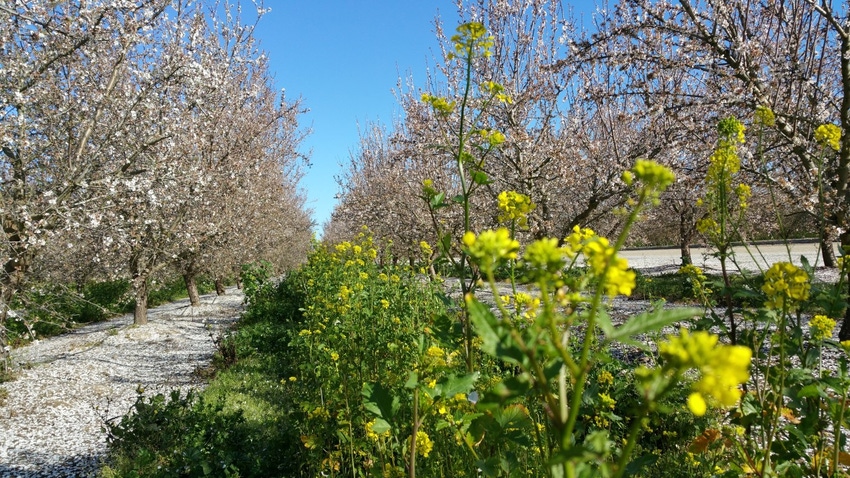February 2, 2017

Honey bees are a valuable resource and almond production input. Their value will continue to heighten as almond acreage increases and bee supplies remain flat because beekeepers continue to face bee health challenges.
Two-thirds of commercial honey bee hives in the U.S. come to California in late winter to pollinate California almonds. The time bees spend in almonds impacts hive health, not just when they are in almonds but throughout the year, until they return the next season.
The overall objective of honey bee best management practices is to ensure that almonds continue as a good and safe place for bees.
When the majority of petals in an almond orchard have fallen, it may be time to remove honey bees if 90 percent of the flowers on the latest blooming variety are at petal fall. Once petals have fallen, no pollination takes place, and bees that forage outside the orchard (up to four miles), seeking alternate sources of food and water, will have a higher risk of coming in contact with insecticide-treated crops.
Staggered pollen release
During bloom, blossoms release pollen for about four days after opening. When temperatures are above 55 degrees Fahrenheit, pollen is released when the anthers split open, or dehisce. Not all anthers will open at once; this happens in progression.
Typically, pollen released each day is collected by bees by mid-afternoon. The pollen-receiving structure - the stigma surface - is receptive to fertilization for about five days after a blossom opens. But, fertilization is most successful when pollination occurs during the first few days that a flower is open.
When 90 percent of the flowers on the latest-blooming variety are at petal fall, no cross-pollination takes place. It is in the bee’s best interest for beekeepers to remove the colonies, regardless of the presence of petals or nectar-foraging bees.
Otherwise, past the point when no pollination is taking place in the orchard the bees will forage, seeking alternate food and water sources, and will have a higher risk of coming in contact with insecticide-treated crops.
Unfortunately, even if bee removal timing may be included in the pollination agreement, keep in mind that beekeepers can’t always be available, or don’t have an alternative location to move the bees.
If you have planted bee forage, there is no rush to remove the bees from the orchard once the last variety is pollinated. The planted forage acts to “anchor” the bees.
Bee forage benefits
Supplemental forage provides bees with natural nutrition before and after almond bloom when there is a dearth of pollen. Ongoing Almond Board of California (ABC)-funded research demonstrates this.
After almond bloom, hives with access to supplemental forage have higher survivorship and perform better. Forage does not compete with almond blossoms - bees go to almonds first.
Acknowledging the health and safety benefits of forage to honey bees, pollination agreements are emerging that discount the hive rental price if forage is planted.
Not only does planting forage on your operation provide a food source for honey bees after pollination it also provides benefits to almond tree acreage growth and other improvements to orchards including: improved soil fertility, water infiltration, and soil moisture conservation; fixed nitrogen; increased organic material and beneficial insects; plus soil stabilization and erosion control.
If a grower does not plant forage and opts to have the beekeeper remove the bees after pollination, it is still recommended to check with the county agricultural commissioner before making insecticide or other pesticide applications since bees may still be foraging in neighboring orchards or in other crops nearby.
For more information on best management practices for honey bees in almonds, including bee forage, please visit www.Almonds.com/BeeBMPs.
You May Also Like




